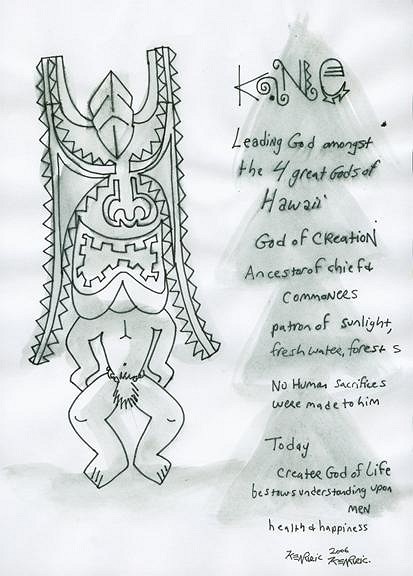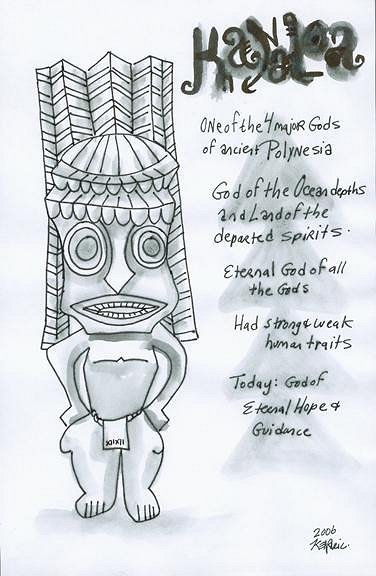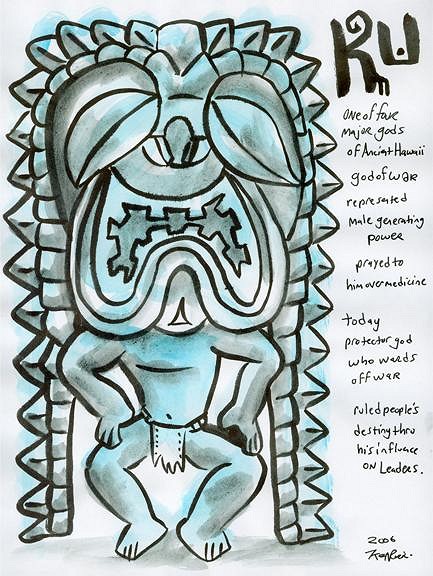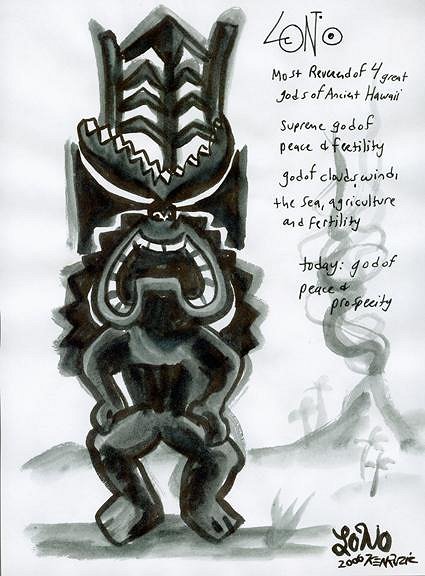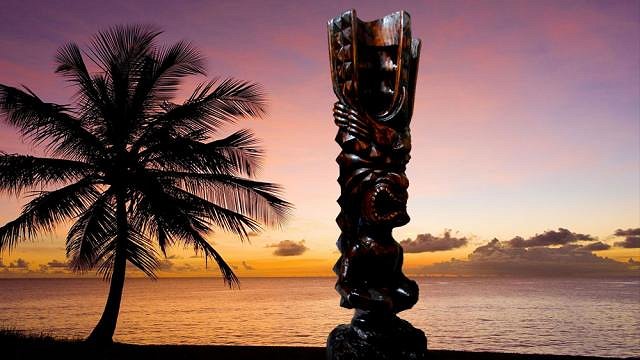Tiki Central / General Tiki
A Brief History of Tiki Gods
Pages: 1 9 replies
|
C
christiki295
Posted
posted
on
Fri, Aug 6, 2004 7:22 PM
I found the following which is a good summary of the primary ancient Hawaiian tiki gods: Ku was the most aggressive and active one and often was associated with war. Ku (male or husband), and Hina (female or wife) were the rulers of the ancient people and are the earliest gods. They are great ancestral gods of earth and heaven who have general control over the bounty of earth and generations of mankind. Ku freed one from their faults and errors. He is associated with sacrifice and prisoners. Ku represents the East, or the sun rising, which indicates morning. Ku equals "rising upright." Hina represents the West, or the sun setting, which indicates evening. Hina means "leaning down." Ku represents the universal character as a god to worship. The Ancient Hawaiians worshiped Ku for things such as good fishing, long life, good crops, and family and national prosperity for a whole. For example, early in the morning, prayers are said by fishermen to Ku to help them with their fishing. These things are represented in the following prayer: "Ku, O Li! Soften your land that it may bring forth. Bring forth where? Bring forth in the sea [naming the fishing grounds], squid, ulua fish... Encourage you land to bring forth. Bring forth where? Bring forth, on land, potatoes, taro, gourds, coconuts, bananas, calabashes. Encourage your land to bring forth. Bring forth what? Bring forth men, women, children, pigs, fowl, food, land. Encourage your land to bring forth. Bring forth what? Bring forth chiefs, commoners, pleasant living; bring about good will, ward off ill will". Kane was the leading god of the great gods named by the Hawaiians. He represented the god of procreation and was worshipped as ancestor of chiefs and commoners. Kane is the creator and gives life associated with dawn, sun and sky. According to the possible late edition of the Kumuhonua legend, he formed the three worlds: the upper heaven of the gods, the lower heaven above the earth, and the earth itself as a garden for mankind; the latter he furnished with sea creatures, plants, and animals, and fashioned man and woman to inhabit it. No human sacrifice or laborious ritual was needed in the worship of Kane. Lono, usually called Lono-makua(Father Lono) was the most humane of the three primary akua. He cared for the crops, maturation, fertility, forgiveness, healing, and other life-sustaining aspects of life. Hawaiian legends tell of Lono appearing to the people many hundreds of years ago and promising to return someday. Captain James Cook was mistakenly identified as Lono when he arrived in the Islandsbecause of these verbal traditions. Hawaiians who accepted Christianity also associated Lono with Jesus Christ. During the rainy winter months of the year, Lono became the dominant akua because warfare was kapu (taboo or forbidden) during this time and the worship of Ku and Kane were temporarily suspended. The clouds and the phenomena of storms are also associated with Lono. When the statement, "with head hidden in the dark clouds above" is recited, it is usually referring to Lono. During prayer to Lono, signs of the god are named thunder, lightening, earthquake, the dark cloud, the rainbow, rain, wind, whirlwinds that sweep the earth, waterspouts, the clustering clouds of heaven, and gushing springs on the mountains. Lono brings on the rains and dispenses fertility. Lono is the god of harvest. Lono-makua (Father Lono), is the name given to portray the god during the Pre-Contact time. Lono's role has generally confined to the celebration of games. Kaneloa was a lesser or secondary akua closely associated with Kane. Kaneloa is the old Polynesian sea god of death, darkness, water, and squid. Under the influence of sorcery, Kane has the character to heal: "Kaneloa, god of the squid, here is your sick man... " ...and ends with an excellent objective description of squid catching. Fishermen will use him for protection but he is looked upon with distrust as an aumakua. There is a legend that the Ancient Hawaiians told about Kaneloa: Kaneloa is associated with the Christian devil. His name is associated with various legends of strife against Kane in which Kaneloa and his spirits rebel and are sent down to the underworld. In the legend of Hawaii-loa belonging to the Kumu-honua epic account of the Kane tradition, Kaneloa is the leader of the first company of spirits placed on earth after earth was separated from heaven. These spirits are "spit out by the gods." They rebel, lead by Kaneloa, because they are not allowed to drink awa, but are defeated and cast down to the underworld, where Kaneloa, otherwise known as Milu, becomes ruler of the dead. The legend places Kane and Kaneloa in opposition as the good and evil wishers of mankind. |
|
S
SugarCaddyDaddy
Posted
posted
on
Mon, Sep 5, 2005 11:20 PM
ChrisTiki, I missed this when you originally posted it. Mahalo for the info & link! |
|
H
hewey
Posted
posted
on
Tue, Sep 6, 2005 6:56 AM
Cool info |
|
V
VampiressRN
Posted
posted
on
Tue, Dec 25, 2007 8:31 AM
Thanks Chris...I have looked for lists of the gods with pictures before and it is hard to find. Here is another list also.Gods and Goddesses of Hawaii (Hawaiian Mythology) Hawaii's ancient beliefs contained gods and goddesses revered throughout all the Islands, as well as many locally important gods. To Westerners it seemed that the ancient Hawaiian gods were a mix of Christian and ancient Roman and Greek gods, though by the time Missionaries arrived in the Islands from New England in the USA, Hawaii's royal rulers had officially cast the ancient Hawaiian religious system aside. For centuries the belief system in Hawaii was enforced by priests (kahunas) and the notion of chief and priest privilege called "kapu," which simply meant "do this or die," ruled secular and religious life in Hawaii. But in 1819 Prince Lilolilo, who had just been crowed Kamehameha II, broke the kapu by dining in public with his mother and other women of the royal court. All kapu were abolished, but they also destroyed Hawaii's temples (heiaus), relics and artifacts because kapu had been so inextricably intertwined with the Islands temples, priests and beliefs. The burning of the temples was urged by the high priest to Hawaii's royal family. However Hawaii's rich cultural heritage is still alive in the Islands, binding oral tradition, archeological science, history and the ecology of the Islands, and there are many historic sites around the Islands that can help visitors and natives better understand the history and the legacy of the ancient Hawaiians. And though all this talk of ancient gods may seem like ancient history, visitors to the volcanoes continually hear about tourists mailing back volcanic rocks and artifacts, originally taken as souvenirs from Kilauea, in order to appease Pele and end their streak of bad luck. Despite everything, the gods live on within their people. Here's a list to help introduce you to Hawaii's ancient deities, along with a set of Web site links covering Hawaii's rich culture. Major Dieties Gods in the Realm of Death (Po) Celestial Dieties Pele - Goddess of the Volcano Gods and Goddesses of the Natural World Gods and Goddesses of Arts and Professions |
|
I
irishf
Posted
posted
on
Mon, Dec 31, 2007 8:09 AM
Wikipedia has this to say about Kanaloa, read more at: depictions of Kanaloa as a god of evil, death, or the Underworld, in conflict with good deities like Kāne (a reading that contradicts Kanaloa and Kāne's paired invocations and shared devotees in Ancient Hawaii) are likely the result of European missionary efforts to recast the four major divinities of Hawaiʻi in the image of the Christian Trinity plus Satan. In traditional, pre-contact Hawaiʻi, it was Milu who was the god of the Underworld and death, not Kanaloa; the related Miru traditions of other Polynesian cultures confirms this. |
|
C
christiki295
Posted
posted
on
Wed, Feb 27, 2008 12:04 AM
Maui does not seem to be referenced, even though his feat is noteworthy by lassoing the sun, to slow its journey over the island, thereby increasing the length of days. |
|
D
domin
Posted
posted
on
Sat, Jan 17, 2015 10:46 PM
thought id bump this up to the top and see if we can add to this thread. lots of good info so far but would be helpfull to have 1 spot to look to see some good representations of each of the major dieties. so if any can post pics and or point out some of the major traits that let you know which tiki your looking at. Kane, Ku, Kaneloa, Lono, and any other minor gods commonly portrayed, hawaiian or other islands. |
|
D
domin
Posted
posted
on
Sun, Jan 18, 2015 9:48 AM
found these sketchs for a start.
thanks to little lost tiki. now to look up some carvings and some of the others. and figure out how to repost others images, not just links. which didnt work anyway damn. [ Edited by: domin 2015-01-18 09:49 ] [ Edited by: Hakalugi - added [img] BB Code to display images - 2015-01-18 10:31 ] |
|
E
EnchantedTikiGoth
Posted
posted
on
Mon, Jan 19, 2015 3:01 PM
I'll throw in here that I've been doing a slow series on the gods represented in the Enchanted Tiki Room's garden for my Disney-ish blog. So far I've written on Tangaroa and Pele (part 1 and part 2). Maui is coming in a month or so, and Rongo probably some time later this year (they're both written, it's just a matter of when they're queued up). |
|
GT

Gone Tiki
Posted
posted
on
Sun, Mar 19, 2017 3:09 PM
I would Love to add my interpretation of Lono |
Pages: 1 9 replies

